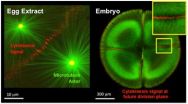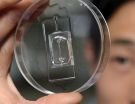Bladderwrack: Tougher than suspected
GEOMAR biologists show a functioning defense system in Fucus vesiculosus despite environmental changes
2014-10-31
(Press-News.org) It is up to 30 centimetres long, it has a green-brown color and is probably known to every beach walker on the North and Baltic Sea: the bladderwrack, a seaweed, which is common on the coasts of the whole North Atlantic area. The bladderwrack provides food and habitat for many other organisms. Its abundance is considered to be an indication of whether a coastal ecosystem is intact or not. Especially in the German Baltic Sea, however, the populations have declined considerably in the past decade. The reasons for this are not yet fully known. "Against this background, it is important to know how environmental changes affect the bladderwrack and why," says biologist Dr. Mahasweta Saha from GEOMAR Helmholtz Centre for Ocean Research Kiel.
As the climate changes, the temperature of the Baltic Sea is rising. The strong input of nutrients in recent years has also led to greater water turbidity and reduced light availability. Therefore, it seems likely that these changes are partly responsible for the decline of bladderwrack populations. But a new study published today in the international science journal PLOS ONE shows that the bladderwrack responds more robustly to these environmental changes than previously thought. "At least the defense against its initial enemies, i.e bacterial foulers that may promote further fouling upon the alga's surface, works even at high temperatures and long periods of darkness," explains Dr. Saha, who is the lead author of the study.
Bacteria generally play a crucial role in the life of seaweeds. Also the bladderwrack lives in symbiosis with many types of bacteria that feed it with certain growth factors and nutrients. On the other hand, some other bacterial species can harm the seaweed. To deter them, Fucus produces different chemical compounds, as Dr. Saha has shown in some of her previous studies. "Until recently one of these compounds was only known to function as a pigment. That it can also play a protective role, was a sensation," the biologist says.
In order to find out whether the delicate system of defensive substances may be affected by environmental changes, the scientists exposed bladderwrack from the Baltic Sea in controlled environmental chambers to increased average temperatures of up to 25 degrees Celsius. Other specimens were held in open experimental chambers on pontoons in the Kiel Fjord ('Benthocosms'). "With the help of special foils we created different light conditions - from normal daylight without changes to permanent darkness," says Dr. Florian Weinberger from GEOMAR, co-author of the current study.
In subsequent analyses, the researchers noted that under changed light or temperature conditions the production of single defensive compounds decreased in comparison to unchanged conditions. "But thanks to the mix of defensive substances the defense as a whole remained effective even at the highest simulated temperatures and in total darkness," says Saha.
The Kiel researchers also found that the same substances that fight off harmful bacteria, attract other bacteria useful for the bladderwrack. "This is also a new finding," said Dr. Weinberger.
Overall, the study demonstrates that defense mechanisms and symbiotic relationships in bladderwrack are much more complicated than previously thought, the researchers say. "If we want to understand exactly why the bladderwrack responds to certain environmental changes, we must know better its metabolism and its relationship to other organisms such as the bacteria," says Saha.
INFORMATION:
ELSE PRESS RELEASES FROM THIS DATE:
2014-10-31
Four minutes of physical activity can improve behaviour in the classroom for primary school students, according to new research by Brendon Gurd.
A brief, high-intensity interval exercise, or a "FUNterval," for Grade 2 and Grade 4 students reduced off-task behaviours like fidgeting or inattentiveness in the classroom.
"While 20 minutes of daily physical activity (DPA) is required in Ontario primary schools, there is a need for innovative and accessible ways for teachers to meet this requirement," says Dr. Gurd, lead researcher and professor in the School of Kinesiology ...
2014-10-31
In the early 1900s, Brazil was the world's largest producer of cocoa. Chocolate trees (Theobroma cacao) were cultivated in a 800, 000 ha region of rainforest in the state of Bahia, beneath a dense canopy of native shade trees. Whereas the surrounding rainforest was a biodiversity hotspot, the chocolate trees, which were derived mainly from a handful of seeds introduced in the mid 1700s, had very low levels of genetic variation. According to Brazilian scientist Gonçalo Pereira, "This scenario created a very romantic, but extremely fragile situation". Genetic variation ...
2014-10-31
In the first study of its kind, Rice University researchers have mapped how information flows through the genetic circuits that cause cancer cells to become metastatic. The research reveals a common pattern in the decision-making that allows cancer cells to both migrate and form new tumors. Researchers say the commonality may open the door to new drugs that interfere with the genetic switches that cancer must flip to form both cancer stem cells and circulating tumor cells -- two of the main players in cancer metastasis.
"Cells have genetic circuits that are used to switch ...
2014-10-31
The process of cell division is central to life. The last stage, when two daughter cells split from each other, has fascinated scientists since the dawn of cell biology in the Victorian era. For just as long, it has been notoriously difficult to study this final step, when the dividing cell creates a furrow before cleaving in two.
The name given to this process by those early biologists, cytokinesis, translates as "cell movement" and captures the sense of a highly active and organized series of events. Scientists have now learned much more about the proteins involved ...
2014-10-31
Santa Barbara, Calif. — Concern about fisheries is widespread around the world. Over the past several decades, a robust discussion has taken place concerning how to manage fisheries better to benefit ecosystems and humans. Much of the discussion has focused on preserving biological diversity, a critical component of healthy ecosystems. One aspect that gets less attention is the role of fishing fleet diversity.
Fishing fleets can be diverse in many ways, including the gear they use, the fishing grounds they visit and when, and the species they target. A new study ...
2014-10-31
WASHINGTON, D.C., October 31, 2014 -- The soundtrack to a wild rhinoceros's life is wind passing through the savannah grass, birds chirping, and distant animals moving across the plains. But a rhinoceros in a zoo listens to children screaming, cars passing, and the persistent hum of urban life.
A group of researchers from Texas believes that this discrepancy in soundscape may be contributing to rhinos' difficulties thriving and reproducing in captivity. During the 168th Meeting of the Acoustical Society of America (ASA), which will be held October 27-31, 2014, at the ...
2014-10-31
DARIEN, IL – New research suggests that insomnia is a major contributor to deaths caused by motor vehicle crashes and other unintentional fatal injuries. The results underscore the importance of the "Sleep Well, Be Well" campaign of the National Healthy Sleep Awareness Project.
Results show that the risk of unintentional fatal injury increased in a dose-dependent manner with the number of insomnia symptoms present. People with all three symptoms of insomnia were 2.8 times more likely to die from a fatal injury than those with no insomnia symptoms, even after adjusting ...
2014-10-31
Nearly one out of four older Americans say that either they or a family member have experienced excessive or unwanted medical treatment, according to the latest issue of The Gerontological Society of America's Public Policy & Aging Report (PP&AR), which goes on to show that Americans strongly support holding doctors accountable when they fail to honor patients' end-of-life health care wishes.
This PP&AR, titled "Advanced Illness Care: Issues and Options," features 12 articles that present new ways of understanding the complexity of securing appropriate advanced illness ...
2014-10-31
A bright synchrotron source that emits over a wide part of the electromagnetic spectrum from the infrared to hard X-rays is currently being built in Lund, Sweden. The MAX IV facility presents a range of technical challenges for the team putting together its component parts in a storage - ring synchrotron system that will have a circumference of just a few hundred metres. Nevertheless, if these various challenges can be addressed then an entirely new class of experiments that require source brightness and transverse coherence will be possible.
Pedro Tavares and colleagues ...
2014-10-31
Johns Hopkins engineers have invented a lab device to give cancer researchers an unprecedented microscopic look at metastasis, the complex way that tumor cells spread through the body, causing more than 90 percent of cancer-related deaths. By shedding light on precisely how tumor cells travel, the device could uncover new ways to keep cancer in check.
The inventors, from the university's Whiting School of Engineering and its Institute for NanoBioTechnology (INBT), published details and images from their new system recently in the journal Cancer Research. Their article ...
LAST 30 PRESS RELEASES:
[Press-News.org] Bladderwrack: Tougher than suspected
GEOMAR biologists show a functioning defense system in Fucus vesiculosus despite environmental changes




